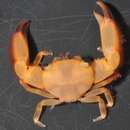en
names in breadcrumbs


The coral crabs, genus Trapezia, include 22 described species found from the Red Sea, Indian Ocean, and across the Pacific. Fourteen species are found in French Polynesia.Trapezia live in specialized obligate mutualisms with pocilloporid and acropoid corals.These crabs live their entire life within the coral branches, where they defend their host from predators, such as seastar and snail corallivores, and remove sediment buildup from the coral structures.In return, coral crabs benefit from shelter provided in the coral’s crevices and graze on lipid nutrients the coral polyps produce when the crabs are present.Large coral colonies can host up to five different species of Trapezia crabs, but usually only one mated pair (and juveniles) from each species.
A recent study carried out in Moorea found that the differently sized Trapezia species provide distinct defensive services for their corals (McKeon and Moore 2014). The largest (T. flavopunctata and T. rufopunctata; carapace width >11 mm) are the only species that can protect from the powerful crown of thorns seastar (Acanthaster planci complex), which especially during population blooms can devastate a coral reef as the highest-impact coral predator.McKeon and Moore (2014) showed that during a Acanthaster outbreak, if these crabs were removed coral colonies (and any other Trapezia species that don’t escape) were completely consumed.However these largest crabs are essentially ineffective at deterring smaller coral predators.
McKeon and Moore's (2014) work indicates that medium sized crab species such T. bidentata and T. serenei (carapace width 9-11 mm) cannot fight crown of thorns but they provide good protection from the smaller seastar Culcita novaeguineae.The smallest Trapezia crabs, T. punctimanus and small-sized T. serenei (4-6 mm carapace width), previously considered of little protective value for their coral hosts, turn out to effectively knock down the muricid gastropod known as the horn drupe (Drupella cornus), which McKeon and Moore cite as the most devastating coral predator after Acanthaster, and which is not preyed upon by the larger Trapezia species.Reflecting the results of experiments showing that these three sizes of crab species show complementary diversity in protective effects upon their hosts, McKeon and Moore determined that the best protected corals are those that are the largest in size, so can harbor multiple species of Trapezia crabs and take advantage of their differential protective effectiveness.
(McKeon and Moore 2014; Tennessen 2014; Castro et al. 2004)
Trapezia is a genus of guard crabs in the family Trapeziidae. Like other members of this family, they live in association with corals, feeding on coral tissue and mucus, and defending the corals from predators, like starfish.[1] It contains the following species:[2]
Trapezia is a genus of guard crabs in the family Trapeziidae. Like other members of this family, they live in association with corals, feeding on coral tissue and mucus, and defending the corals from predators, like starfish. It contains the following species:
 A red-spotted guard crab (Trapezia tigrina) protecting its home, a cauliflower coral (Pocillopora meandrina). Trapezia areolata Dana, 1852 Trapezia bella Dana, 1852 Trapezia bidentata (Forskål, 1775) Trapezia cheni Galil, 1983 Trapezia corallina Gerstaecker, 1857 Trapezia cymodoce (Herbst, 1801) Trapezia digitalis Latreille, 1828 Trapezia flavopunctata Eydoux & Souleyet, 1842 Trapezia formosa Stimpson, 1869 Trapezia garthi Galil, 1983 Trapezia globosa Castro, 1997 Trapezia guttata Rüppell, 1830 Trapezia intermedia Miers, 1886 Trapezia lutea Castro, 1997 Trapezia neglecta Castro, 2003 Trapezia punctimanus Odinetz, 1984 Trapezia punctipes Castro, 1997 Trapezia richtersi Galil & Lewinsohn, 1983 Trapezia rufopunctata (Herbst, 1799) Trapezia septata Dana, 1852 Trapezia serenei Odinetz, 1984 Trapezia speciosa Dana, 1852 Trapezia tigrina Eydoux & Souleyet, 1842
A red-spotted guard crab (Trapezia tigrina) protecting its home, a cauliflower coral (Pocillopora meandrina). Trapezia areolata Dana, 1852 Trapezia bella Dana, 1852 Trapezia bidentata (Forskål, 1775) Trapezia cheni Galil, 1983 Trapezia corallina Gerstaecker, 1857 Trapezia cymodoce (Herbst, 1801) Trapezia digitalis Latreille, 1828 Trapezia flavopunctata Eydoux & Souleyet, 1842 Trapezia formosa Stimpson, 1869 Trapezia garthi Galil, 1983 Trapezia globosa Castro, 1997 Trapezia guttata Rüppell, 1830 Trapezia intermedia Miers, 1886 Trapezia lutea Castro, 1997 Trapezia neglecta Castro, 2003 Trapezia punctimanus Odinetz, 1984 Trapezia punctipes Castro, 1997 Trapezia richtersi Galil & Lewinsohn, 1983 Trapezia rufopunctata (Herbst, 1799) Trapezia septata Dana, 1852 Trapezia serenei Odinetz, 1984 Trapezia speciosa Dana, 1852 Trapezia tigrina Eydoux & Souleyet, 1842